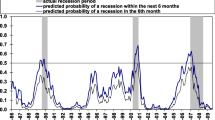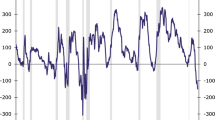Abstract
Recently De Luca and Carfora (Statistica e Applicazioni 8:123–134, 2010) have proposed a novel model for binary time series, the Binomial Heterogenous Autoregressive (BHAR) model, successfully applied for the analysis of the quarterly binary time series of U.S. recessions. In this work we want to measure the efficacy of the out-of-sample forecasts of the BHAR model compared to the probit models by Kauppi and Saikkonen (Rev Econ Stat 90:777–791, 2008). Given the substantial indifference of the predictive accuracy between the BHAR and the probit models, a combination of forecasts using the method proposed by Bates and Granger (Oper Res Q 20:451–468, 1969) for probability forecasts is analyzed. We show how the forecasts obtained by the combination between the BHAR model and each of the probit models are superior compared to the forecasts obtained by each single model.












Similar content being viewed by others
Notes
We have also computed the same test for different values of \(v\). The general results do not change. However, for \(h=4\) the combination of forecasts seems to suffer from the comparison with the static and the dynamic model when the value of \(v\) increases. This fact can be explained by the presence in the probit models of the variable \(x_{t-4}\) which gives a relevant contribute to the forecasts four period ahead.
References
Bates JM, Granger CWJ (1969) The combination of forecast. Oper Res Q 20:451–468
Clemen RT (1989) Combining forecasts: a review and annotaded bibliography. Int J Forecast 5:559–583
Clements MP, Harvey DI (2011) Combining probability forecasts. Int J Forecast 27:208–223
Cox DR (1981) Statistical analysis of time series: some recent developments. Scan J Stat 8:93–115
De Luca G, Carfora A (2010) A binary time series Model with a long memory structure. Statistica e Applicazioni 8:123–134
Diebold FX (1988) Serial correlation and the combination of forecasts. J Bus Econ Stat 6:105–111
Diebold FX, Mariano R (1995) Comparing predictive accuracy. J Bus Econ Stat 13:253–263
Dueker M (1997) Stengthening the case for the yield curve as a predictor of U.S. recessions. Fed Reserve Bank of St. Louis Econ Rev 79:41–51
Estrella A, Mishkin FS (1998) Predicting U.S. recessions: financial variables as leading indicators. Rev Econ Stat 80:45–61
Granger CWJ, Ramanathan R (1984) Improving method of combining forecast. J Forecast 3:197–204
Harvey D, Leybourne S, Newbold P (1997) Testing the equality of prediction mean squared errors. Int J Forecast 13:281–291
Kamstra M, Kamstra P (1998) Combining qualitative forecasts using logit. Int J Forecast 14:83–93
Kauppi H, Saikkonen P (2008) Predicting U.S. recessions with dynamic binary response models. Rev Econ Stat 90:777–791
Nyberg H (2010) Dynamic probit models and financial variables in recession forecasting. J Forecast 29: 215–230
Startz R (2008) Binomial autoregressive moving average models with an application to U.S. recessions. J Bus Econ Stat 26:1–8
Zeger SL, Qaqish B (1988) Markov regression models for time-series: a quasi-likelihood approach. Biometrics 44:1019–1031
Author information
Authors and Affiliations
Corresponding author
Rights and permissions
About this article
Cite this article
De Luca, G., Carfora, A. Predicting U.S. recessions through a combination of probability forecasts. Empir Econ 46, 127–144 (2014). https://doi.org/10.1007/s00181-012-0671-4
Received:
Accepted:
Published:
Issue Date:
DOI: https://doi.org/10.1007/s00181-012-0671-4




